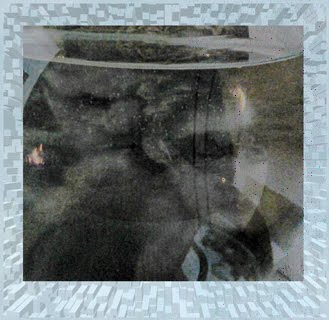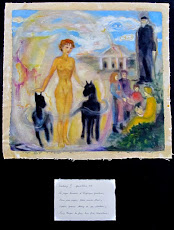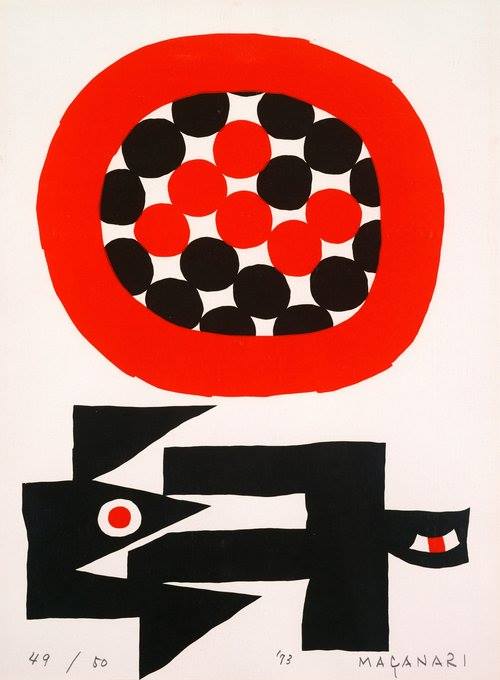 |
| Crédits en bas / • Credits below / Phyllis Lambert & Francesco Garutti @ Pierre grise: Des outils pour comprendre la ville. / • Greystone: Tools for understanding the city. Photos © Lena Ghio, 2017 |
Pierre grise: Des outils pour comprendre la ville 12.10.2017 > 04.03.2018
Il y a quelques semaines, on s'est fait traiter à une visite guidée avec Madame Phyllis Lambert, fondatrice du Centre Canadien d'Architecture, en compagnie de Francesco Garutti, Conservateur, architecture contemporaine. En 1973 et 1974 elle entreprend avec Richard Pare la tâche de documenter les bâtiments à pierres grises de notre belle ville. Madame Lambert est reconnue pour sa prescience en architecture et quel beau cadeau nous avons aujourd'hui de pouvoir revisité notre patrimoine à travers son travail de documentation minutieux.
Comme toujours, l'exposition est fascinante. C'est comme un grand roman historique raconté par des splendides devantures d'édifices. L'exposition est multimédia avec des catalogues que vous pouvez emprunter pour suivre l'évolution de l'architecture de la ville. Voici l'introduction à l'exposition par Madame Lambert:
« Les bâtiments de pierre grise qui se dressent
aujourd’hui à Montréal illustrent des modèles d’établissement ayant perduré de
la fin du xviie siècle au début du xxe siècle. Une
analyse approfondie de leur histoire révèle l’influence de facteurs
géologiques, topographiques, politiques, économique, culturels et ethniques qui
ont façonné la ville au cours du temps.
Parmi
les modes d’analyse possibles du tissu urbain, l’accent sur un seul matériau de
construction permet d’aborder un large éventail de sujets. Cette approche
serait moins fructueuse dans des villes comme Paris ou Jérusalem, où tous les
bâtiments présentent des parements en pierre locale. Cependant, à Montréal, la
ville avec la plus grande concentration de bâtiments de pierre en Amérique du
Nord, une telle analyse est révélatrice. Initialement le produit de
préoccupations purement pragmatiques, les bâtiments de pierre calcaire grise de
Montréal, qui se distinguent de ceux construits dans d’autres matériaux, ont accru
une valeur symbolique particulière. Aux xviie et xviiie
siècles, des murs de pierre épais offraient une protection contre les attaques,
le feu et le froid. Plus tard, ils devinrent des insignes de statut social
prestigieux.
Lors
des hivers de 1973 et 1974, j’ai entrepris une mission photographique aux côtés
de Richard Pare, à l'aide d’une chambre photographique pour étudier la
croissance urbaine. Ce mission deviendrait un catalyseur des préoccupations
croissantes entourant la conservation du patrimoine de la ville. Les bâtiments
de pierre grise offrent un principe unificateur à toute l’île de Montréal. Tôt
le matin, nous pataugions dans la neige pour aller photographier les quartiers
présentés dans cette exposition : le Vieux-Montréal et les faubourgs originaux
situés directement au nord de celui-ci, ainsi que d’autres faubourgs et
quartiers périphériques sur l’île de Montréal, tels que cartographiés en 1890.
Les
photographies sont les protagonistes de cette exposition. Elles sont élargies
et complétées par des cartes et des textes interprétatifs, fruits d’une
recherche poussée sur les dates de construction et sur l’identité des
titulaires, propriétaires ou occupants des bâtiments à l’époque de leur
construction. Les atlas utilisés par les assureurs, les cartes historiques de
la ville, plans cadastraux, relevés de cotisations fiscales municipales,
annuaires de la ville, actes notariés, documents personnels et autres documents
et comptes de société constituent des sources primaires essentielles pour construire
une histoire sociale du changement urbain et qui viennent confirmer les modèles
et les hypothèses dégagés par l’étude approfondie des documents visuels. »
12.10.2017 > 04.03.2018
A few weeks ago, we were treated to a
guided tour with Madame Phyllis Lambert, founder of the Canadian Center for
Architecture, along with Francesco Garutti, curator, contemporary architecture. In 1973 and 1974 she undertook with
Richard Pare the task of documenting the greystone buildings of our beautiful
city. Madame Lambert is recognized for her prescience in architecture and what
a great gift we have today to revisit our heritage through her thorough work of
documentation.
As always, the exhibition is fascinating.
It's like a great historical novel told by splendid storefronts. The exhibition is multimedia with catalogs
that you can borrow to follow the evolution of the architecture of the city. Here is the introduction to the exhibition
by Madame Lambert:
« The gray stone buildings now standing in
Montreal illustrate settlement patterns that lasted from the end of the 17th
century to the beginning of the 20th century. An in-depth analysis of their
history reveals the influence of geological, topographical, political,
economic, cultural and ethnic factors that have shaped the city over time.
Among the possible modes of analysis of
the urban fabric, the focus on a single building material makes it possible to
approach a wide range of subjects. This approach would be less successful in
cities like Paris or Jerusalem, where all buildings have local stone cladding.
However, in Montreal, the city with the largest concentration of stone
buildings in North America, such an analysis is revealing. Initially the
product of purely pragmatic concerns, Montreal's gray limestone buildings,
which differ from those built in other materials, have increased a particular
symbolic value. In the seventeenth and eighteenth centuries thick stone walls
offered protection against attack, fire and cold. Later, they became
prestigious status insignia.
During the winters of 1973 and 1974, I
undertook a photographic mission alongside Richard Pare, using a photographic
chamber to study urban growth. This mission would become a catalyst for growing
concerns surrounding the preservation of the city's heritage. The gray stone
buildings offer a unifying principle throughout the island of Montreal. Early
in the morning, we wade through the snow to photograph the neighborhoods
presented in this exhibition: Old Montreal and the original suburbs located
directly north of it, as well as other suburbs and outlying areas on the island
of Montreal, as mapped in 1890.
The photographs are the protagonists of
this exhibition. They are enlarged and supplemented by maps and interpretative
texts, the result of extensive research on the dates of construction and the
identity of the owners, owners or occupants of buildings at the time of their
construction. Insurers' atlases, historic city maps, cadastral maps, municipal
tax slips, city directories, notarial records, personal documents and other
corporate documents and accounts are essential primary sources for building a
social history of urban change that confirm the models and hypotheses derived
from the in-depth study of visual documents. »
-LENA GHIO
PHOTOS:
Portrait de Phyllis Lambert, 2017. © CCA, Montréal / Portrait of Phyllis Lambert, 2017. © CCA, Montréal
Phyllis Lambert et Richard Pare. Magasin-entrepôt Jodoin, Vieux-Montréal Centre, 1872-1873. Photographie prise entre1973 et 1974. Collection Phyllis Lambert © Phyllis Lambert et Richard Pare. / Phyllis Lambert and Richard Pare. Jodoin Warehouse, Old Montreal Centre, 1872-1873. Photograph taken between 1973 and 1974. Phyllis Lambert Collection. © Phyllis Lambert and Richard Pare.
Phyllis Lambert et Richard Pare. Baxter Block, Saint Laurent, 1892. Photographie prise entre1973 et 1974. Collection Phyllis Lambert © Phyllis Lambert et Richard Pare. / Phyllis Lambert and Richard Pare. Baxter Block, Saint Laurent, 1892. Photograph taken between 1973 and 1974. Phyllis Lambert Collection. © Phyllis Lambert and Richard Pare.

























No comments:
Post a Comment